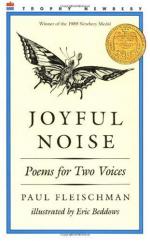
|
| Name: _________________________ | Period: ___________________ |
This test consists of 15 multiple choice questions and 5 short answer questions.
Multiple Choice Questions
1. What is some of the vocabulary used by the poet to describe the grasshoppers?
(a) Hurdlers, racers, gymnasts, slow-moving.
(b) Acrobats, circlers, twirlers, flippers.
(c) Bounders, leapers, springers, soarers, bounders, leapers, springers, soarers.
(d) Sliders, runners, sprinters. spinners.
2. How do the mayflies spend their time?
(a) Lazily flying about.
(b) Frantically flying about.
(c) Sleeping.
(d) Eating.
3. The mayfly's birth and death take place when?
(a) One year apart.
(b) In the same day.
(c) In different places.
(d) At the beginning and end of one week.
4. What do the two lice spend this poem doing?
(a) Arguing with each other.
(b) Trying to climb to a higher shelf.
(c) Eating glue from the book bindings.
(d) Describing their lives on various book shelves and their life as a couple.
5. How does the poet accurately describe the behavior of a moth in this poem?
(a) By describing the way the moth moves.
(b) By giving it human emotions and feelings.
(c) By comparing the moth's movements to music.
(d) By having the two speakers talk at the same time.
6. How is the letter F important in "Fireflies?"
(a) Many words beginning with the letter F are used to describe the flight and light of the firefly through the night sky.
(b) It is the letter used for the first word of every line.
(c) Only the important words begin with the letter F.
(d) Almost every word begins with the letter F.
7. What does the vocabulary in "Grasshoppers" do for the readers?
(a) It makes the movements of the grasshoppers seem confusing.
(b) It creates a vivid image in the reader's mind of the actions of a grasshopper.
(c) It makes the grasshoppers seem lazy.
(d) It creates a strange image in the reader's mind of the actions of a grasshopper.
8. What does the mayfly desire?
(a) More friends.
(b) A longer life.
(c) More food.
(d) A shorter life.
9. To what else does the poet also compare the firefly?
(a) Zipping, zooming, and zany behavior.
(b) Acting, shouting, ordering others around.
(c) Painting and brush strokes.
(d) Singing, vocalizing, and warbling.
10. What is the mood of "Book Lice?"
(a) Angry.
(b) Humorous.
(c) Serious.
(d) Anxious.
11. "Fireflies" tells of the _________ of a firefly.
(a) Life.
(b) Food.
(c) Light.
(d) Sounds.
12. Why do these two book lice compromise?
(a) They have to share a shelf.
(b) They have to share a book.
(c) They like to compromise.
(d) They are in love.
13. "Mayflies" ________________ tells of the brief life of the mayfly.
(a) Sadly.
(b) Dramatically.
(c) Matter-of-factly.
(d) Angrily.
14. How do the mayflies see their youth?
(a) They think nothing of their youth.
(b) As an anxious period of time.
(c) As only yesterday.
(d) As so very long ago.
15. How do the mayflies view their lives?
(a) As a relatively short time.
(b) As entirely too long.
(c) As a relatively long time.
(d) As a waste of time.
Short Answer Questions
1. Who reads which part of this book?
2. What kind of poem is "Moth's Serenade?"
3. The poet compares the firefly to what?
4. How are these two book lice opposites?
5. How did other types of insects react to the water strider's abilities?
|
This section contains 585 words (approx. 2 pages at 300 words per page) |

|




